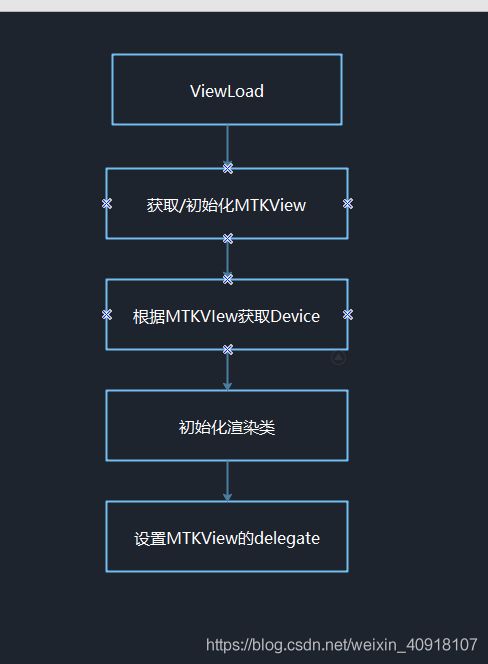Metal(一) 三角形绘制
1.Metal 简介
Metal 是针对 iPhone 和 iPad 中 GPU 编程的高度优化的框架。其名字来源是因为 Metal 是 iOS 平台中最底层的图形框架 (意指 “最接近硬件”)。
优点:
- cpu 使用率低;
- Metal 将苹果的GPU 发挥最⼤性能;
- 最⼤限度CPU/GPU 并发性;
- 方便管理我们资源
2. 函数解析
2.1
//每当视图改变方向或调整大小时调用
(void)mtkView:(nonnull MTKView *)view drawableSizeWillChange:(CGSize)size;
2.2
//每当视图需要渲染帧时调用
- (void)drawInMTKView:(nonnull MTKView *)view
3. 绘制三角形

注:苹果官方建议Metal渲染类与ViewController类分开实现,所以下面我们在ViewController类中实现MTKView的加载,在Metal渲染类中实现渲染逻辑。
3.1创建并编辑Metal文件
// 顶点着色器输出和片段着色器输入
//结构体
typedef struct
{
//处理空间的顶点信息
float4 clipSpacePosition [[position]];
//颜色
float4 color;
} RasterizerData;
- 定义顶点着色器函数 和 片元着色器函数
//顶点着色函数
vertex RasterizerData
vertexShader(uint vertexID [[vertex_id]],
constant Vertex *vertices [[buffer(VertexInputIndexVertices)]],
constant vector_uint2 *viewportSizePointer [[buffer(VertexInputIndexViewportSize)]])
{
/*
处理顶点数据:
1) 执行坐标系转换,将生成的顶点剪辑空间写入到返回值中.
2) 将顶点颜色值传递给返回值
*/
//定义out
RasterizerData out;
// //初始化输出剪辑空间位置
// out.clipSpacePosition = vector_float4(0.0, 0.0, 0.0, 1.0);
//
// // 索引到我们的数组位置以获得当前顶点
// // 我们的位置是在像素维度中指定的.
// float2 pixelSpacePosition = vertices[vertexID].position.xy;
//
// //将vierportSizePointer 从verctor_uint2 转换为vector_float2 类型
// vector_float2 viewportSize = vector_float2(*viewportSizePointer);
//
// //每个顶点着色器的输出位置在剪辑空间中(也称为归一化设备坐标空间,NDC),剪辑空间中的(-1,-1)表示视口的左下角,而(1,1)表示视口的右上角.
// //计算和写入 XY值到我们的剪辑空间的位置.为了从像素空间中的位置转换到剪辑空间的位置,我们将像素坐标除以视口的大小的一半.
// out.clipSpacePosition.xy = pixelSpacePosition / (viewportSize / 2.0);
out.clipSpacePosition = vertices[vertexID].position;
//把我们输入的颜色直接赋值给输出颜色. 这个值将于构成三角形的顶点的其他颜色值插值,从而为我们片段着色器中的每个片段生成颜色值.
out.color = vertices[vertexID].color;
//完成! 将结构体传递到管道中下一个阶段:
return out;
}
//当顶点函数执行3次,三角形的每个顶点执行一次后,则执行管道中的下一个阶段.栅格化/光栅化.
// 片元函数
//[[stage_in]],片元着色函数使用的单个片元输入数据是由顶点着色函数输出.然后经过光栅化生成的.单个片元输入函数数据可以使用"[[stage_in]]"属性修饰符.
//一个顶点着色函数可以读取单个顶点的输入数据,这些输入数据存储于参数传递的缓存中,使用顶点和实例ID在这些缓存中寻址.读取到单个顶点的数据.另外,单个顶点输入数据也可以通过使用"[[stage_in]]"属性修饰符的产生传递给顶点着色函数.
//被stage_in 修饰的结构体的成员不能是如下这些.Packed vectors 紧密填充类型向量,matrices 矩阵,structs 结构体,references or pointers to type 某类型的引用或指针. arrays,vectors,matrices 标量,向量,矩阵数组.
fragment float4 fragmentShader(RasterizerData in [[stage_in]])
{
//返回输入的片元颜色
return in.color;
}
3.2创建C 与 OC的桥接文件
该头文件的目的是为了c代码与OC代码可以共享与 shader 和 C 代码 为了确保Metal Shader缓存区索引能够匹配 Metal API Buffer 设置的集合调用
/*
介绍:
头文件包含了 Metal shaders 与C/OBJC 源之间共享的类型和枚举常数
*/
#ifndef ShaderTypes_h
#define ShaderTypes_h
// 缓存区索引值 共享与 shader 和 C 代码 为了确保Metal Shader缓存区索引能够匹配 Metal API Buffer 设置的集合调用
typedef enum VertexInputIndex
{
//顶点
VertexInputIndexVertices = 0,
//视图大小
VertexInputIndexViewportSize = 1,
} VertexInputIndex;
//结构体: 顶点/颜色值
typedef struct
{
// 像素空间的位置
// 像素中心点(100,100)
vector_float4 position;
// RGBA颜色
vector_float4 color;
} Vertex;
#endif
3.3 ViewController类
- (void)viewDidLoad {
[super viewDidLoad];
// Do any additional setup after loading the view, typically from a nib.
//1. 获取_view
_view = (MTKView *)self.view;
//2.为_view 设置MTLDevice(必须)
//一个MTLDevice 对象就代表这着一个GPU,通常我们可以调用方法MTLCreateSystemDefaultDevice()来获取代表默认的GPU单个对象.
_view.device = MTLCreateSystemDefaultDevice();
//3.判断是否设置成功
if (!_view.device) {
NSLog(@"Metal is not supported on this device");
return;
}
//4. 创建Renderer
//分开你的渲染循环:
//在我们开发Metal 程序时,将渲染循环分为自己创建的类,是非常有用的一种方式,使用单独的类,我们可以更好管理初始化Metal,以及Metal视图委托.
_render =[[Renderer alloc]initWithMetalKitView:_view];
//5.判断_render 是否创建成功
if (!_render) {
NSLog(@"Renderer failed initialization");
return;
}
//6.设置MTKView 的代理(由Renderer来实现MTKView 的代理方法)
_view.delegate = _render;
//7.视图可以根据视图属性上设置帧速率(指定时间来调用drawInMTKView方法--视图需要渲染时调用)
_view.preferredFramesPerSecond = 60;
}
3.4 Metal渲染类
设置MTKView,准备工作
//初始化MTKView
- (nonnull instancetype)initWithMetalKitView:(nonnull MTKView *)mtkView
{
self = [super init];
if(self)
{
NSError *error = NULL;
//1.获取GPU 设备
_device = mtkView.device;
//2.在项目中加载所有的(.metal)着色器文件
// 从bundle中获取.metal文件
id<MTLLibrary> defaultLibrary = [_device newDefaultLibrary];
//从库中加载顶点函数
id<MTLFunction> vertexFunction = [defaultLibrary newFunctionWithName:@"vertexShader"];
//从库中加载片元函数
id<MTLFunction> fragmentFunction = [defaultLibrary newFunctionWithName:@"fragmentShader"];
//3.配置用于创建管道状态的管道
MTLRenderPipelineDescriptor *pipelineStateDescriptor = [[MTLRenderPipelineDescriptor alloc] init];
//管道名称
pipelineStateDescriptor.label = @"Simple Pipeline";
//可编程函数,用于处理渲染过程中的各个顶点
pipelineStateDescriptor.vertexFunction = vertexFunction;
//可编程函数,用于处理渲染过程中各个片段/片元
pipelineStateDescriptor.fragmentFunction = fragmentFunction;
//一组存储颜色数据的组件
pipelineStateDescriptor.colorAttachments[0].pixelFormat = mtkView.colorPixelFormat;
//4.同步创建并返回渲染管线状态对象
_pipelineState = [_device newRenderPipelineStateWithDescriptor:pipelineStateDescriptor error:&error];
//判断是否返回了管线状态对象
if (!_pipelineState)
{
//如果我们没有正确设置管道描述符,则管道状态创建可能失败
NSLog(@"Failed to created pipeline state, error %@", error);
return nil;
}
//5.创建命令队列
_commandQueue = [_device newCommandQueue];
}
return self;
}
绘制
//每当视图需要渲染帧时调用
- (void)drawInMTKView:(nonnull MTKView *)view
{
//1. 顶点数据/颜色数据
static const Vertex triangleVertices[] =
{
//顶点, RGBA 颜色值
{ { 0.5, -0.25, 0.0, 1.0 }, { 1, 0, 0, 1 } },
{ { -0.5, -0.25, 0.0, 1.0 }, { 0, 1, 0, 1 } },
{ { -0.0f, 0.25, 0.0, 1.0 }, { 0, 0, 1, 1 } },
};
//2.为当前渲染的每个渲染传递创建一个新的命令缓冲区
id<MTLCommandBuffer> commandBuffer = [_commandQueue commandBuffer];
//指定缓存区名称
commandBuffer.label = @"MyCommand";
//3.
// MTLRenderPassDescriptor:一组渲染目标,用作渲染通道生成的像素的输出目标。
MTLRenderPassDescriptor *renderPassDescriptor = view.currentRenderPassDescriptor;
//判断渲染目标是否为空
if(renderPassDescriptor != nil)
{
//4.创建渲染命令编码器,这样我们才可以渲染到something
id<MTLRenderCommandEncoder> renderEncoder =[commandBuffer renderCommandEncoderWithDescriptor:renderPassDescriptor];
//渲染器名称
renderEncoder.label = @"MyRenderEncoder";
//5.设置我们绘制的可绘制区域
/*
typedef struct {
double originX, originY, width, height, znear, zfar;
} MTLViewport;
*/
//视口指定Metal渲染内容的drawable区域。 视口是具有x和y偏移,宽度和高度以及近和远平面的3D区域
//为管道分配自定义视口需要通过调用setViewport:方法将MTLViewport结构编码为渲染命令编码器。 如果未指定视口,Metal会设置一个默认视口,其大小与用于创建渲染命令编码器的drawable相同。
MTLViewport viewPort = {
0.0,0.0,_viewportSize.x,_viewportSize.y,-1.0,1.0
};
[renderEncoder setViewport:viewPort];
//[renderEncoder setViewport:(MTLViewport){0.0, 0.0, _viewportSize.x, _viewportSize.y, -1.0, 1.0 }];
//6.设置当前渲染管道状态对象
[renderEncoder setRenderPipelineState:_pipelineState];
//7.从应用程序OC 代码 中发送数据给Metal 顶点着色器 函数
//顶点数据+颜色数据
// 1) 指向要传递给着色器的内存的指针
// 2) 我们想要传递的数据的内存大小
// 3)一个整数索引,它对应于我们的“vertexShader”函数中的缓冲区属性限定符的索引。
[renderEncoder setVertexBytes:triangleVertices
length:sizeof(triangleVertices)
atIndex:VertexInputIndexVertices];
//viewPortSize 数据
//1) 发送到顶点着色函数中,视图大小
//2) 视图大小内存空间大小
//3) 对应的索引
[renderEncoder setVertexBytes:&_viewportSize
length:sizeof(_viewportSize)
atIndex:VertexInputIndexViewportSize];
//8.画出三角形的3个顶点
// @method drawPrimitives:vertexStart:vertexCount:
//@brief 在不使用索引列表的情况下,绘制图元
//@param 绘制图形组装的基元类型
//@param 从哪个位置数据开始绘制,一般为0
//@param 每个图元的顶点个数,绘制的图型顶点数量
/*
MTLPrimitiveTypePoint = 0, 点
MTLPrimitiveTypeLine = 1, 线段
MTLPrimitiveTypeLineStrip = 2, 线环
MTLPrimitiveTypeTriangle = 3, 三角形
MTLPrimitiveTypeTriangleStrip = 4, 三角型扇
*/
[renderEncoder drawPrimitives:MTLPrimitiveTypeTriangle
vertexStart:0
vertexCount:3];
//9.表示已该编码器生成的命令都已完成,并且从NTLCommandBuffer中分离
[renderEncoder endEncoding];
//10.一旦框架缓冲区完成,使用当前可绘制的进度表
[commandBuffer presentDrawable:view.currentDrawable];
}
//11.最后,在这里完成渲染并将命令缓冲区推送到GPU
[commandBuffer commit];
}


